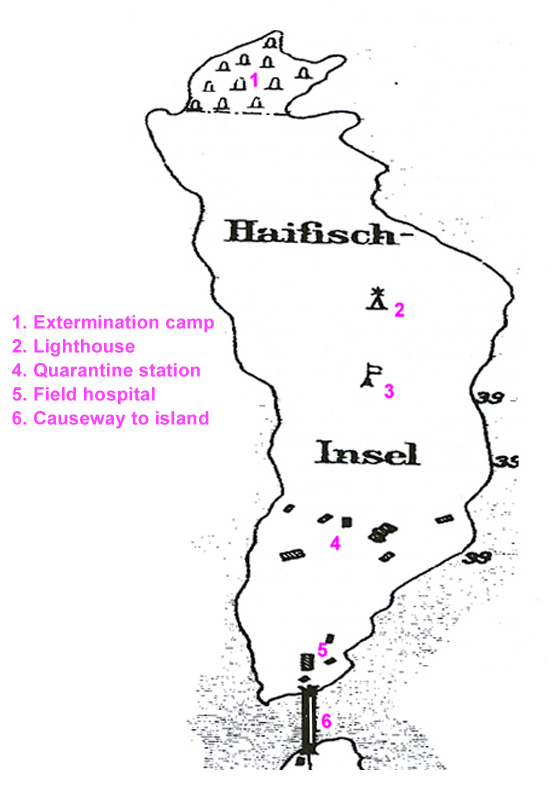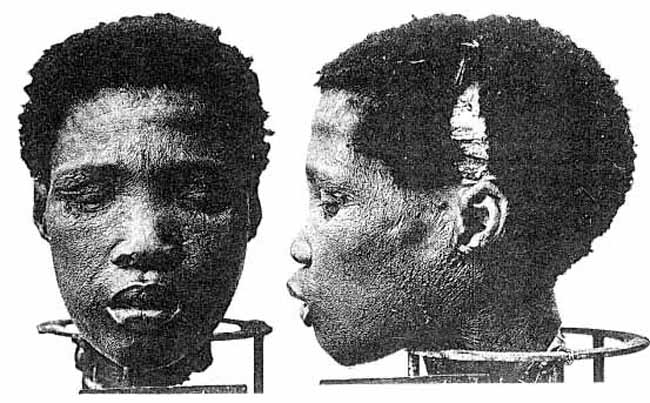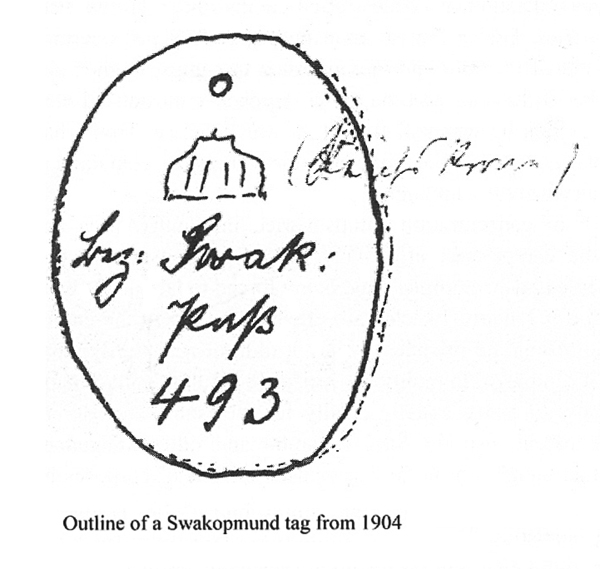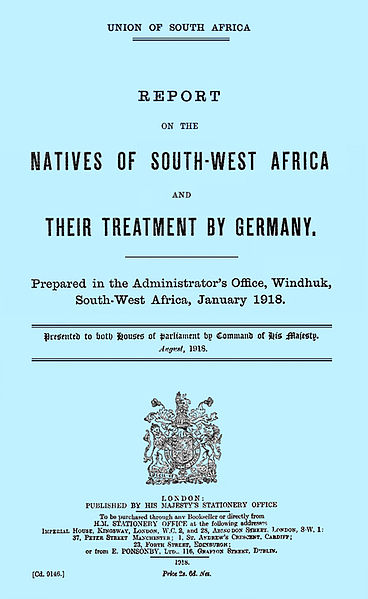Esther M. Zimmer Lederberg Memorial Website
Eugenics
Shark Island Extermination Camp
Shark Island, German South West Africa was the world's
first Extermination Camp (Vernichtungslager).
The objective of the policy of German South West Africa Governor
Theodor von Leutwein was not to destroy the indigenous populations
(Herero, Nama, Damara) in order to seize their land to encourage
settlement of German farmers; nor was it to seize or kill the cattle.
Leutwein's objective was not genocide, and he was wise enough to
realize that the indigenous population could be used as a labor
supply. However, such Flavian tactics (Fabius Maximus, opposing
Hannibal) left Leutwein open to attack at home, with a public who
wanted the instant gratification of a decisive defeat of the
indigenous peoples of German South West Africa. (This was the same
problem Fabius Maximus had with the Roman public, who wanted him to
quickly defeat Hannibal.) As a consequence, Leutwein was pushed
aside by Kaiser Wilhelm II and replaced by Lothar von Trotha,
already known for his brutality in China as well as German East
Africa. The result was the genocide of the indigenous population,
the economic ruin of German South West Africa, and the eventual
loss of the German colonial empire.1, 2
As a consequence of this failed, brutal policy, Trotha was forced
to leave German South West Africa and replaced by Friedrich von
Lindequist, who completed the genocide with the use of extermination
camps and concentration camps. In order for this policy to be
acceptable at home, propaganda was employed. The claim was made that
the 'barbaric' indigenous population wished to murder defenseless
women and children. In fact, only four German women were killed, and
one German child.
Shark Island Extermination Camp is regarded as the world's first extermination
camp (Vernichtungslager). Three thousand Herero and Namaqua rebels
in the German-Herero conflict of 1904-1908 died there. While one of the
first known uses of the concentration camp was in Cuba during the
Spanish-American War in 1896 (by General Valeriano "Butcher" Weyler,
followed by the British during the Second Boer War,3, 4,
Shark Island was the first "camp" created with the explicit purpose of
extermination, rather than being solely for containment. Since the extermination
at Shark Island was restricted to specific peoples, it was the first recorded
effort to exterminate a race or a people; thus constituting genocide or
or ethnic cleansing.
Arrival at Shark Island
Just as with the extermination and concentration camps during the Third
Reich, unsuspecting victims were transported by train or on foot from
collection camps or other concentration camps to Shark Island Death Camp.
The less lucky (such as those who were sick or starving) were shot before
they got to Shark Island.5
The weather was typically ice-cold gale force winds. The prisoners (men,
women and children) usually had no or very few blankets, little food
(they were provided with rice but had no prior familiarity with rice,
nor did they have the required cooking utensils), families were split
apart. Violence from German schutztruppers (protectorate army)
wielding sjamboks (whips) was common, as was rape.6, 7
Conditions at Shark Island
One should bear in mind that, as previously noted (see the table of
concentration camps at German South West Africa),
indigenous people were interned by the German colonial government, in a
number of other concentration camps, collection camps and work camps:
"There were numerous smaller and lesser concentration camps in the
colony. Some pertained to private businesses such as the Woermann
company [active in other German colonies such as German Togoland,
German Kamaruun, and German South Pacific colonies] and others
to government related projects such as railway construction, which
saw several thousands of Herero 'accommodated' in 'Railway
Concentration Labour Camps'."8
.
"Hereros working in Swakopmund had been rounded up and interned on two
Woermann line ‘steamers’ anchored off the coastal town’s shores."9
.
"Firma Lenz used slave labor to build railway embankments."10
.
"The Arthur Koppel Company constructed the Otavi railroad."11
.
"Etappenkommando in charge of supplies of prisoners to companies,
private persons, etc., as well as any other materials. Concentration
camps implies poor sanitation and a population density that would imply
disease."12
.
Prisoners were used as slave laborers in mines and railways, for use by the
military or settlers:
.
"The loads … are out of all proportion to
their strength. I have often seen women and children dropping down, especially
when engaged on this work, and also when carrying very heavy bags of grain,
weighing from 100 to 160lbs."14
.
"The unfortunate [POW] women are daily compelled to carry heavy iron for construction
work, also big stacks of compressed
fodder. I have often noticed cases where women have fallen under the load and have
been made to go on by being thrashed and kicked by the soldiers and conductors.
The rations supplied to the women are insufficient and they are made to cook the
food themselves. They are always hungry, and we, labourers from the Cape Colony,
have frequently thrown food into their camp. The women in many cases are not properly
clothed. It is a common thing to see women going about in public almost naked. Have
also noticed that - old women are also made to work and are constantly kicked and
thrashed by soldiers. This treatment is meted out in the presence of the German
officers, and I have never noticed any officers interfering."15
.
"I have seen women and children with my own eyes
at Angra Pequena, dying of starvation and overwork, nothing but skin and bone, getting
flogged every time they fell under the heavy loads. I have seen them picking up bits
of bread and refuse food thrown away outside our tents (…) … most of the prisoners,
who compose the working gangs at Angra Pequena, are sent up from Swakopmund. There
are hundreds of them, mostly women and children and a few old men… When they fall they
are sjamboked by the soldier in charge of the gang, with his full force, until they get
up. Across the face was the favourite place for the sjamboking and I have often seen the
blood flowing down the faces of the women and children and from their bodies, from the
cuts of the weapon. (…) The women had to carry the corpses and dig the hole into which
they were placed. They had no burial ceremony of any kind … The corpse would be wrapped
in a blanket and carried on a rough stretcher … I have never heard one cry, even when
their flesh was being cut to pieces with the sjambok. All feeling seemed to have gone
out of them (…)"16
.
"I left Cape Town during the year 1906, and signed
on with the Protectorate troops in South West Africa. I arrived at Luderitzbrucht, and
after staying there a few minutes I perceived nearly 500 native women lying on the beach,
all bearing indications of being slowly starved to death. Every morning and towards evening
four women carried a stretcher containing about four or five corpses, and they had also to
dig the graves and bury them. I then started to trek to Kubub and Aus, and on the road I
discovered bodies of native women lying between stones and devoured by birds of prey. Some
bore signs of having been beaten to death … If a prisoner were found outside the Herero
prisoners’ camp, he would be brought before the Lieutenant and flogged with a sjambok.
Fifty lashes were generally imposed. The manner in which the flogging was carried out was
the most cruel imaginable … . Pieces of flesh would fly from the victim’s body into the air …"17
.
"Forcing women to pull carts as if they were animals was in tune with the treatment
generally meted out to Herero prisoners in Luderitz as elsewhere in the colony. Missionary
Vedder in Swakopmund noted that overall, prisoners were regarded no better than animals. He
said: ‘Like cattle hundreds were driven to their death and like cattle they were buried.’"18
Medical Experimentation
The skulls of prisoners were harvested to be used as part of the
medical experimentation program to prove that the indigenous peoples
of German South West Africa were of an inferior race. These skulls
were studied by such people as Eugen Fischer (see F. Birkner and H. von
Eggeling19, and Dr. Bofinger.
Exposing Shark Island Extermination Camp
In August 1912, before the First World War, a British foreign office
official commented:
In view of the cruelty, treachery [and] commercialism by which the
German colonial authorities have gradually reduced their natives to
the status of cattle (without so much of a flutter being caused
among English peace loving philanthropists) the [Portuguese] S.
Thome agitation in its later phases against a weak [and] silly
nation without resources is the more sickening. These Hereros were
butchered by thousands during the war & have been ruthlessly flogged
into subservience since.20
The Report on the natives of South-West Africa and their treatment
by Germany. Administrator's Office, Windhuk [sic], London: His
Majesty's Stationery Office, 1918 is known as "The Blue Book". It was
removed from sale in 1926 and destroyed.
"A number of eyewitness accounts do exist and some victim accounts are
found in the Blue Book, which recorded accounts of the atrocities
committed during the Herero war. Since the British produced the Blue
Book during World War I reservations about its objectivity remain.
However, the sentiments contained in the 1918 Report were already
present in a British report of 1909, which stated:
"The great aim of German policy in German South West Africa, as
regards the native, is to reduce him to a state of serfdom, and,
where he resists, to destroy him altogether. The native, to the
German, is a baboon and nothing more. The war against the Hereros,
conducted by General Von Trotha, was one of extermination; hundreds
-- men, women and children -- were driven into desert country, where
death from thirst was their end; whose [sic] left over are now in
great locations near Windhuk [sic] where they eke out a miserable
existence; labour is forced upon them and naturally is unwillingly
performed.21
"The Blue Book was the first investigation into the genocide. As
Rhoda Howard-Hassmann points out, 'Germany committed genocide in
South-West Africa with an impunity broken only by a British inquiry
after the former country's defeat in World War I. So keen were the
German settlers to suppress evidence of the genocide that they
attempted to have the Blue Book banned as post-war British propaganda.
The all-white legislative assembly adopted a motion to destroy all
copies of it. Its distribution was prohibited and library copies were
removed and destroyed. In the rest of the British Empire, the Blue Book
was also removed from libraries and sent to the Foreign Office.'"22
1
Jeremy Sarkin, "Germany's Genocide of the
Herero: Kaiser Wilhelm II, His General, His Settlers, His Soldiers", James Currey,
2011
.
2
Casper Erichsen, "The angel of death has descended violently among them,"
African Studies Centre, Leiden, 2005
.
3
Aline Helg, "Our Rightful Share: The Afro-Cubal Struggle for Equality,
1886-1912", The University of North Carolina Press, Chapel Hill, 1995, pp. 85-86
.
4
Willard B. Gatewood, Jr., "Smoked Yankees and the Struggle for Empire:
Letters from Negro Soldiers 1898-1902", University of Arkansas Press,
Fayetteville, 1987, p. 239
.
5
Casper Erichsen, "The angel of death
has descended violently among them: Concentration camps and prisoners-of-war
in Namibia, 1904-1908," African Studies Centre, Leiden, 2005
.
6
It has been reported that the sjamboks
tore off pieces of flesh. See photographs of Maria in Plate 4 (facing p. 174)
and Auma, Plate 5 (facing p. 175), in the British Blue Book of 1918. This
punishment was so common in German Kamerun that the country was referred to as
"the 25 Country" because 25 strokes with the sjambok could kill the victim.
.
7
Beatings with the sjambok and other
forms of abuse were common. See the testimony of Joseph Witbooi, quoted from
the British Blue Book, in Casper W. Erichsen, "The angel of death has descended
violently among them: Concentration camps and prisoners-of-war in Namibia, 1904-08",
African Studies Centre Research Report 79/2005, p. 121-122
.
8
Casper Erichsen, "The angel of death has descended violently among them:
Concentration camps and prisoners-of-war in Namibia, 1904-1908," African
Studies Centre, Leiden, 2005, p. 49
.
3
Casper Erichsen, "The angel of death has descended violently among them:
Concentration camps and prisoners-of-war in Namibia, 1904-1908," African
Studies Centre, Leiden, 2005, p. 23
.
10
Casper Erichsen, "The angel of death has descended violently among them:
Concentration camps and prisoners-of-war in Namibia, 1904-1908," African
Studies Centre, Leiden, 2005, pp. 59, 111
.
11
Casper Erichsen, "The angel of death has descended violently among them:
Concentration camps and prisoners-of-war in Namibia, 1904-1908," African
Studies Centre, Leiden, 2005, p. 76
.
12
Casper Erichsen, "The angel of death has descended violently among them:
Concentration camps and prisoners-of-war in Namibia, 1904-1908," African
Studies Centre, Leiden, 2005, p. 113
.
13
Casper Erichsen, "The angel of death has descended violently among them:
Concentration camps and prisoners-of-war in Namibia, 1904-1908," African
Studies Centre, Leiden, 2005, p. 43
.
14
Casper Erichsen, "The angel of death has descended
violently among them: Concentration camps and prisoners-of-war in Namibia,
1904-1908," African Studies Centre, Leiden, 2005, p. 58.
.
15
Casper Erichsen, "The angel of death has descended violently among them:
Concentration camps and prisoners-of-war in Namibia, 1904-1908," African
Studies Centre, Leiden, 2005, pp. 60-61.
.
16
Casper Erichsen, "The angel of death has descended violently among them:
Concentration camps and prisoners-of-war in Namibia, 1904-1908," African
Studies Centre, Leiden, 2005, p. 78.
.
17
Casper Erichsen, "The angel of death has descended violently among them:
Concentration camps and prisoners-of-war in Namibia, 1904-1908,"
African Studies Centre, Leiden, 2005, p. 80.
.
18
Casper Erichsen, "The angel of death has descended violently among them:
Concentration camps and prisoners-of-war in Namibia, 1904-1908,"
African Studies Centre, Leiden, 2005, p 84.
.
19
Christian Fetzer, "Rassenanatomische
Untersuchungen an 17 Hottentotten Kopfen", Zeitschrift fur Morphologie und
Anthropologie 16 (1913-1914), pp. 95-156.
.
20
Report by Captain H. S. P. Simon, 'Report on
German South West Africa', 6 April 1909, FO 367-236, quoted in W. M.R. Louis,
'Great Britain and German expansion in Africa 1984-1919'. In P. Gifford and W. M. R.
Louis (Eds.), "Britain and Germany in Africa: Imperial rivalty and colonial rule."
Yale University Press, New Haven, 1967m pp. 3-46, 38.
.
21
This reference pre-dates World War I, and
therefore should not be influenced by war purposes. Report by Captain H. S. P. Simon,
'Report on German South West Africa', 6 April 1909, FO 367-236, quoted in Louis,
W. M. R. (1967) 'Great Britain and German expansion in Africa 1984-1919'. In P.
Gifford and W. M. R. Louis (Eds.), "Britain and Germany in Africa: Imperial rivalty
and colonial rule." Yale University Press, New Haven, pp. 3-46, 33-34.
.
22
Casper W. Erichsen, "The angel of death has
descended violently among them: Concentration camps and prisoners-of-war in Namibia,
1904-08", African Studies Centre, Leiden, 2005, pp. 111-112.
Back




